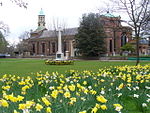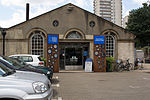Kew Cricket Club
1732 in England1732 in sports1737 in England1737 in sports1882 establishments in England ... and 10 more
Club cricket teams in EnglandCricket grounds in LondonEnglish cricket teams in the 18th centuryKew, LondonKew GreenSport in the London Borough of Richmond upon ThamesSports clubs and teams in LondonSports venues completed in 1973St Mary's University, TwickenhamUse British English from February 2023

Kew Cricket Club plays matches on Kew Green in Kew, which is now in the London Borough of Richmond upon Thames. The club was formed in 1882 following the amalgamation of two local clubs, Kew Oxford Cricket Club and Kew Cambridge Cricket Club, but cricket had been played on Kew Green for many years before this. In August 1732, the Whitehall Evening Post reported that Frederick, Prince of Wales attended "a great cricket match" at Kew on Thursday 27 July. A report in The London Evening Post dated 16 July 1737 refers to a match between a Prince of Wales XI and The Duke of Marlborough XI.
Excerpt from the Wikipedia article Kew Cricket Club (License: CC BY-SA 3.0, Authors, Images).Kew Cricket Club
Kew Green, London Kew (London Borough of Richmond upon Thames)
Geographical coordinates (GPS) Address Nearby Places Show on map
Geographical coordinates (GPS)
| Latitude | Longitude |
|---|---|
| N 51.48458 ° | E -0.28846 ° |
Address
Kew Green
TW9 3AH London, Kew (London Borough of Richmond upon Thames)
England, United Kingdom
Open on Google Maps










